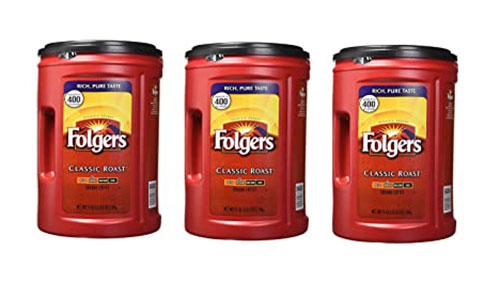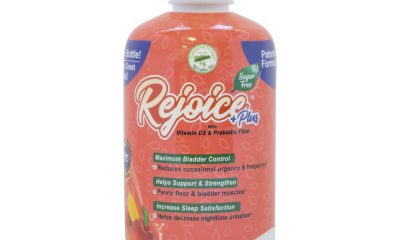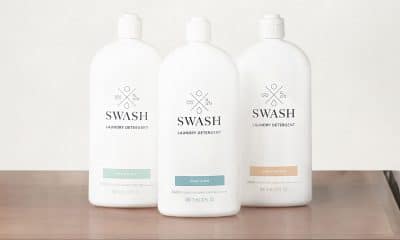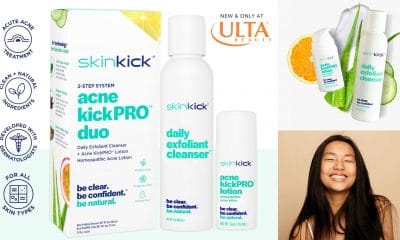Rigid Plastic
Getting A Handle, Seeing Red: Folgers Asserts Brand Equity With Provocative Packaging
“The red color screams Folgers,” says brand strategist.
Published
14 years agoon
By
BXP StaffFOLGERS COULD HAVE MADE news simply by switching its retail coffee containers from steel to plastic, but the top-selling Procter & Gamble (P&G) brand has grander ambitions for its packaging than that. Folgers’ new AromaSeal Canister also introduces a flavor-protecting air valve, a special tight lid, and an easy-to-grip handle, all combined in a package that’s said to trumpet the product’s brand identity in a new and powerful way. According to P&G, the AromaSeal Canister’s design features work in harmony both to promote the product and to enhance what the Folgers brand is all about—the “consumer coffee experience.”

AromaSeal Canisters will replace metal cans in all Folgers product lines.
AromaSeal Canisters, which began appearing on store shelves in the 39 oz. size last September, are lightweight, stackable, and recyclable containers that eventually will replace metal cans in all Folgers product lines. Consumers, according to P&G, will find plastic a friendlier, safer packaging material than metal, with its sharp edges and its affinity for can openers. Indeed, says Tonia Hyatt, a spokesperson for Folgers at P&G, the switch from metal to plastic was driven by concern for consumers’ needs, not by visions of cost-cutting in package manufacturing. “It was not an economic decision,” she says. “There are no savings associated with it.”
Graphically speaking, the AromaSeal Canister isn’t a radical departure from the metal packaging it will replace. Hyatt says that overall, the new package has “the same footprint, architecture, and design theme” as the traditional metal can. Nevertheless, the AromaSeal Canister contains an underlying design element that’s intended to magnify the product’s brand image even beyond what can be achieved by text and visual images.
John Recker, vice president-brand strategy at LPK (Libby Perszyk Kathman), a brand identity firm for Folgers in Cincinnati, Ohio, explains that in showcasing a product like Folgers coffee, color can be everything—and color is what the AromaSeal Canister conveys in abundance.
Pump Up the Volume
He notes that from a brand marketing point of view, the biggest advantage of a using a plastic canister is that the packaging material itself can be red, unlike a metal can covered with a red-colored shrink label. Red, he says, is one of Folgers’ “brand equities” — a signal characteristic that’s readily recognized by consumers. By being inherent in the material of the AromaSeal Canister, says Recker, “the red color screams Folgers.”
AdvertisementThis is no mere blast of sound and fury, adds Recker, but a calculated attempt to out-shout an attention-getting adversary on supermarket shelves. According to Recker, given that Folgers’ “biggest competitor is Maxwell House, and their equity color is blue,” the integral red of the AromaSeal package is a strong reassertion of Folgers’ dominant position among leading coffee brands (see sidebar). He says it even makes up for the fact that the AromaSeal Canister’s unique shape affords a bit less space for text and graphics than the shrink labeling of the metal cans, which can be printed around their entire circumference.
Instead of shrinkable label stock, the AromaSeal Canister uses heat transfer labeling—a composition of inks, protective lacquers, and adhesives. The labels are gravure-printed in seven colors of ink including two applications of white for good opacity. The printed labels are then fused onto the surface of the canisters with a special thermal applicator to complete the process.
Pour A Cup of Folgers, and Another, and Another…
f you’re Folgers, it’s not exactly lonely at the top of the list of America’s 30 best-selling coffee brands. Folgers Ground Coffee, the number 1 leader with better than 14 percent of all dollar sales and units, has six other Folgers-branded products among the remaining 29 to keep it company. According to data from Information Resources Inc. (IRI), these seven brands together accounted for $720,168,264 in sales—almost 26 percent of all top-30 sales—during the 52-week period ending on Nov. 2, 2003. It was a similar story in units: the Folgers seven claimed 175,910,531 units, or nearly 25 percent of the total, in this period. The pie charts show Folgers Ground Coffee’s leading shares of dollars and units among the top five brands.
(The foregoing information was furnished to Package Design by Information Resources Inc. (IRI, www.infores.com), a sales and marketing research firm in the global consumer goods industry. IRI’s services include data gathering and analysis; in-store, scanner-based sales tracking and marketing information; analysis of consumer attitudes and behavior; and CPGNetwork.com, an Internet information delivery system. The company has offices in 11 cities throughout the U.S.)
Elements of Style
Recker says that LPK was involved in the development of the new package from the outset of the process—an effort that spanned two years, according to P&G’s Hyatt. LPK partnered with P&G to develop the AromaSeal name, visual identity, and package graphics.
The firm says that its creative strategy was to leverage all of the Folgers brand equities—the white signature logotype, the sun-and-mountain graphic, and the color red—to maximize shelf impact and to ensure clear communication of the convenience, freshness, and safety aspects of the AromaSeal canister. According to LPK, the AromaSeal typographic treatment conveys the aromatic aspect of the coffee through the swirl that underscores the name.
AdvertisementLPK also designed the canister’s label, its foil seal, and the graphics for its embossed lid. In addition, the firm developed in-store marketing communications for the nationwide rollout.
P&G hopes that consumers drawn to the canister’s arresting appearance will be equally impressed by the quality of the product that they find inside. Hyatt explains that a one-way valve in the foil seal protects aroma and flavor by permitting gases to escape from the freshly packed product while the canisters are in transit. De-gassing in transit, says Hyatt, means that when coffee in AromaSeal Canisters arrives at the store, it will be fresher and more flavorful than coffee delivered in metal containers—hence the enhancement of the “consumer coffee experience.”
Changeover Will Be Gradual
She says that Folgers drinkers’ desire to multiply the experience has made the 39 oz. package the brand’s most requested size. The popular Classic Roast blend was chosen as the first Folgers product to make the transition from steel to plastic, but there’s no firm schedule for migrating the rest of the line. “It is just going to happen over time,” Hyatt says.

BXP elevates the value of innovative and collaborative brand package design as a strategic business competence across the omni-channel path to purchase, to ultimately help consumer facing and retail brands deliver more relevant experiences that connect with shoppers, win at shelf, own the moment of sale and maximize brand loyalty.
SPONSORED VIDEO
Branding with Ferocity – Thinking Like an Indie Brand
Get a better understanding on how to leverage new technologies to engage and delight shoppers, sustainability’s role in product and package design – being sustainable and premium are not mutually exclusive, plus best practices and tips for collaboration and how to launch new products and refresh existing product line-ups and brands.
You may like
Advertisement

GO MINIMALISM . . . HOLD ON A MINUTE!
Sustainable, 100% Recycled Transparent Sheeting is Now a Reality!

Kroger, Walgreens to Dedicate Section of Their Stores to Reusable Packaging

6 Marketing Tips for Ecommerce Brands to Win the Holiday Shopping Season

New Wunderoots Branding Celebrates the Carrot

Fact or Fiction? The Truth about Eco-Friendly Packaging

BXP May 2021 Think & Clink

Unilever Raises Bar for Accessibility with Degree Inclusive

Crown Royal’s Limited-Edition Pack Designed by Oscar-Winner

Coca-Cola Explores World of Paper Bottles
Subscribe

BULLETINS
Get the most important news and business
ideas from BXP Magazine's news bulletin.
Latest Tweets
Advertisement








